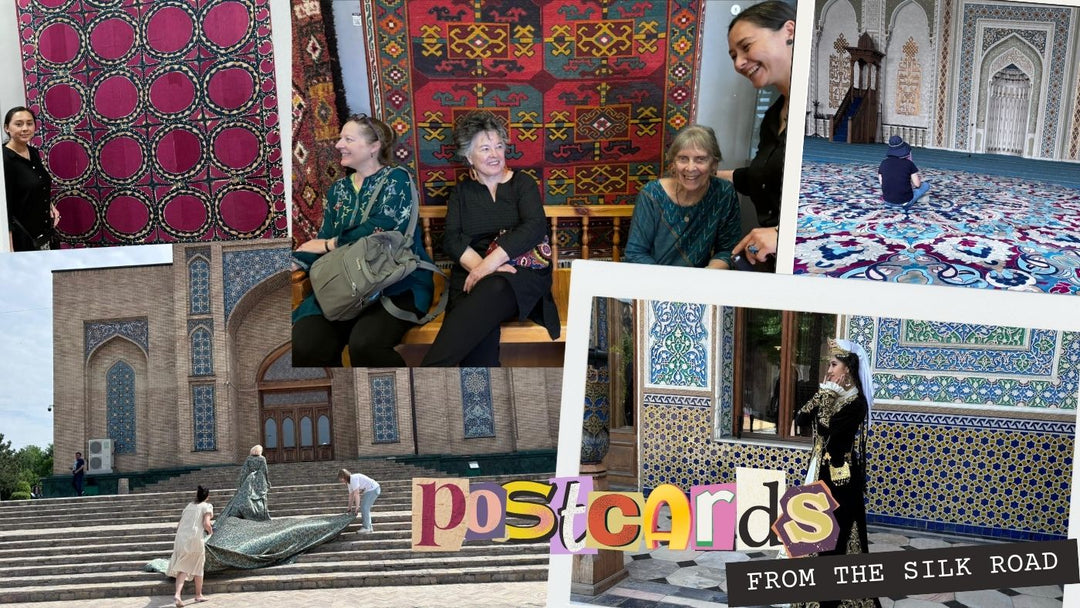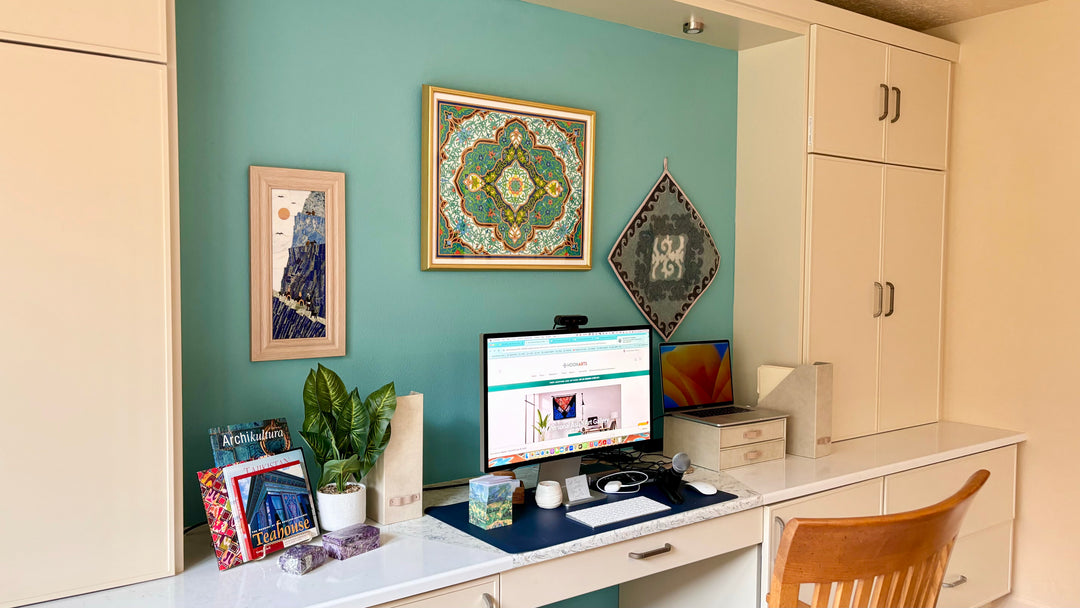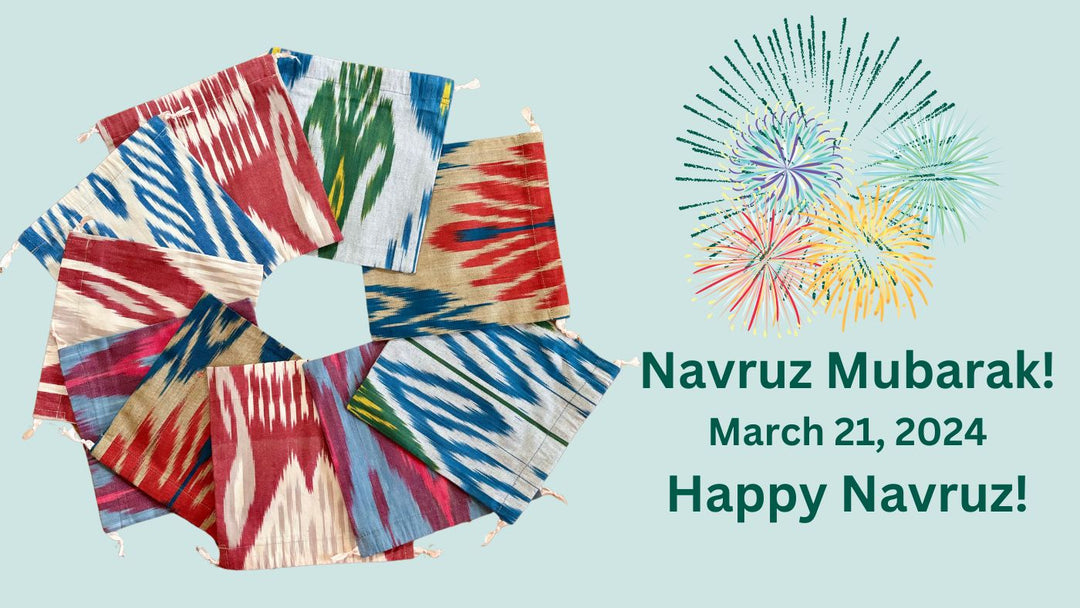Who knew that a comb could be the key to opening a doorway to unknown worlds and building bridges across time and space? In Part I of this blog, I took you down the historical path behind the two-sided Egyptian comb that our Tajik master woodcarver, Sodiq Zaripov, is in the process of recreating.
Today I want to show off the fantastic reproductions that Master Sodiq has created, as well as a bit about the broad reach of two-sided combs throughout Asia, Europe, and Egypt. You'll also hear from Kevin Schott of the Penn Museum, who explained more about how the Museum will use these reproductions to help bring the daily experiences of ancient Egyptians to life for museum visitors of all ages.
Tah Dah!! The Magic Hands of Master Sodiq.
The first reaction of Master Sodiq when he saw the photos was, "Oh my gosh, I'm not sure I can reproduce that. The fine teeth are very skinny, and I'm not sure I can do that." However, I think Master Sodiq viewed it as a personal challenge of his talents and skills, and he took on the effort.
Here are the fantastic results!
The original:

The reproductions from Master Sodiq:

Apricot wood on the left, walnut on the right.
Master Sodiq also created an alternate comb version with the fine teeth used in his now "standard" modern two-sided comb, which are not quite as skinny as the teeth in the original Egyptian comb. This alternate version is slightly smaller than the original to preserve the proportions between the two teeth sizes. (I suspect that Master Sodiq may have made the smaller version first, in case he couldn't carve an exact replica of the original Egyptian comb.)

Comparing the two sizes of reproduction combs.
We also had an interesting exchange about how Master Sodiq should finish the comb, how smooth and shiny the wood should be polished. The final decision was to make the combs smooth (no splinters for small hands or lawsuits) but not shiny to preserve the authentic look.
As you can imagine, Joe Balmos and the Penn Museum were pretty amazed by the results! So Master Sodiq is busy working on a special order of the "exact reproduction" version, which should arrive in a few weeks. The order also includes some additional copies for other fans of Egyptian archeology, courtesy of Joe Balmos' Facebook connections. We also hope that eventually, the Penn Museum Gift Shop might be interested in placing an order.
The Long and Glorious History of the Two-Sided Comb
In the course of my little foray into the history of our Egyptian comb, I discovered that two-sided combs have an unusual story. It turns out that two-sided wooden combs had a long history in Egypt. It began as early as the Egyptian New Kingdom. Two-sided combs continued to be popular through the Greek period discussed in Part One, through the Roman/Coptic period (3rd-4th centuries), the Byzantine period (4th-7th centuries), and the Islamic period that began with the Arab conquest in the 7th period.
The style spread throughout these ancient empires, including to the Judean desert, Greece, Italy, and the British Isles, even appearing in thirteenth-century Russia. And, of course, Central Asia at the northeastern edge of these shifting empires. No one knows where the design originated or if it popped up simultaneously in multiple spots.
The two-sided style also expanded to new materials, including composite wooden combs made of multiple thin, flat pieces of wood or bone riveted together. It also appeared in ivory during the Islamic period.
The most common wood used for the "Roman" style two-sided comb was boxwood, a fine-grained hardwood ideal for carving, believed to have been harvested from dense forests of old-growth boxwood in Greece and Asia Minor (especially the Black Sea coast) in the eastern part of the Mediterranean, as well as northern Italy, northern Spain and perhaps also the western part of southern France.
Most archeologists now believe that people used the fine-tooth side of the combs for handling lice, while they used the larger teeth for combing hair of both men and women, as well as beards. The two-sided comb thus became a convenient multi-faceted tool that spread throughout a vast region and lives on today in the work of Master Sodiq of Tajikistan, whose combs are famous throughout Central Asia.
If you want to geek out on wooden combs and ancient history, you can check out the following:
(1) Serçe Limani - An Eleventh-Century Shipwreck - Volume I, pp. 278-79 (more about this shipwreck in Turkey below)
(2) Wooden Combs from the Roman fort at Vechten: the bodily appearance of soldiers, Journal of Archeology in the Low Countries, 2-2 (November 2010)
(3) Simply Google "two-side Roman comb," and you will find a variety of images of wooden combs found throughout the Roman Empire region and now held by many museums around the world.
Other Reproduction Possibilities

Two-sided wooden comb fragments recovered from 11th Century shipwreck at Serçe Limanı in Turkey.
The Egyptian comb project led to contacts from a couple of other ancient history fans wondering if Tajik artists could reproduce certain artifacts. The first request was to replicate a heavily damaged double-sided comb from an 11th-century shipwreck at Serçe Limanı, Turkish for "Sparrow Harbor," a small, protected bay on the southwest coast of Turkey, just opposite Rhodes. The second request was to create replicas of a wooden bowl and hand-forged knife for use by a historical re-enactment group in the UK focusing on the Sogdians, an ancient Persian civilization in present-day Uzbekistan, Tajikistan, Kazakhstan, and Kyrgyzstan. (Most of our present-day Tajik artists live in the northern Sughd Province, named after the Sogdians.)
We're exploring both projects and will let you know how these new requests turn out.

Kevin Schott & a Glimpse into the Museum Interpretive Programs

One of the highlights of this fascinating journey through time and space was my behind-the-scenes interview with Kevin Schott, Associate Director of Interpretive Programs at Penn Museum in Philadelphia. (In case you've forgotten, our original Egyptian comb is on display in the Mummies Gallery of the Penn Museum.) As Kevin explained, "I always tell people, I'm a failed social studies teacher." But, after training as a teacher, he "quickly realized that the only part of teaching I like is the teaching part of teaching." He eventually discovered that "museum education is a place for you to do just the most fun parts of teaching." Kevin works with all ages of museum visitors but especially loves working with the K-12 education programs.
In discussing the Museum's extensive collection of Egyptian artifacts, Kevin explained:
"We feel extremely lucky to be able to take care of these amazing artifacts, and to be able to give researchers access to them and be able to share them with the public . . . . We are trying to allow these artifacts to tell their stories and to inspire people and to allow people to still be connected to them."
The Museum is famous for its collection of Egyptian artifacts, numbering 20 to 40,000 in total. As explained in Part One of this blog, many artifacts came to the Museum through its sponsorship of various Egyptian archeological expeditions, including the 1902 distribution from the Grenfell & Hunt expedition that excavated our comb in the Fayum area southwest of Cairo.
Another part of the collection came from the 1960s when Egypt built the Aswan Dam, which involved flooding some ancient archeological sites. Penn Museum was one of the institutions invited by the government of Egypt to help with surveying the areas to be flooded and protecting archeological artifacts. In return, the Museum received access to some of the archeological artifacts preserved from flooding.
The Museum's Interpretive Programs arose out of the desire to connect visitors with the past.
"We really do want visitors who come to the Museum to feel connected with the people who come before them and to feel like the people whose artifacts we have on display in the Museum were real people like them, with similar concerns, similar interests. . . .
Looking at artifacts is obviously one way to do that. And, of course, to keep the artifacts safe, they can't be handled too much.
We've learned that there's a lot of power in putting replica artifacts in people's hands. They can feel the weight and the texture, and they can really imagine . . . , if they were to use this, what it would be like.
It really does inspire that deeper connection and deeper interest in people in the past. Because it makes people in the past seem more like real people. . . . And so even common artifacts, like a comb, can really make ancient people seem more real."
This connection to the past through touching artifacts works equally well with kids and adults. "I have never encountered a group of people who didn't want to get the chance to feel a replica artifact or who didn't appreciate the opportunity to look at an ancient bronze mirror and see their reflection."
The Museum uses replica artifacts in a wide variety of ways. For example, they might be used as part of a classroom-type exploration exercise, where students are invited to examine a collection of artifacts to figure out what kind of room they came from and what life was like for the people of that time. For example, an individual lamp and a cup might indicate that the artifacts came from a home. On the other hand, a set of large amphoras for oil might suggest a warehouse because people wouldn't use such large containers in an individual home. Replica artifacts are also incorporated into tours and public displays on the Museum floor.
Kevin is still developing the ancient Egypt interpretive program, so we don't know precisely how the Museum will use our Egyptian comb reproductions. The development process includes just "trying to see what sort of replicas are even available." A lot of their replicas come from a company in Germany, Roman House.
Some of the artifacts they'll be working with include (1) a writer's palette that Egyptian scribes used for writing, (2) woven baskets made from palm leaves (essentially the same as papyrus), and (3) some ancient fragrances containing general ingredients like lotus oil or myrrh and cinnamon used in ancient Egypt.
Kevin also emphasized that he always tries to balance the past by giving visitors a sense of what it's like today for the modern descendants of these ancient civilizations. He wants to avoid having people get "stuck in the past." As Kevin explained, even though the students he taught as a Peace Corps volunteer in Jordan were shepherds, they weren't the "Nativity scene" version of shepherds. "You can be a modern shepherd. And have a cell phone and be . . . texting with your friends as you're herding sheep."
It's inspiring to see that Penn Museum's Interpretive Programs have much the same mission as HoonArts: to open doorways to different times and cultures while also recognizing our shared humanity.
Although we'll probably never know whether the two-sided comb originated in the West or the East, HoonArts is delighted to be able to contribute to the Penn Museum's interpretive program about everyday life in ancient Egypt.
It's one more example of how inter-connected the world is, not only in modern times but in the past as well. As Kevin noted, "Cultural fusion has always happened. It's not new; we didn't invent it. Globalization is not nearly as new as some people might think."
We'll let you know when Master Sodiq's replica combs arrive! I ordered a few extras for HoonArts, so you might be able to snag one for the Egyptologist in your life.







Leave a comment